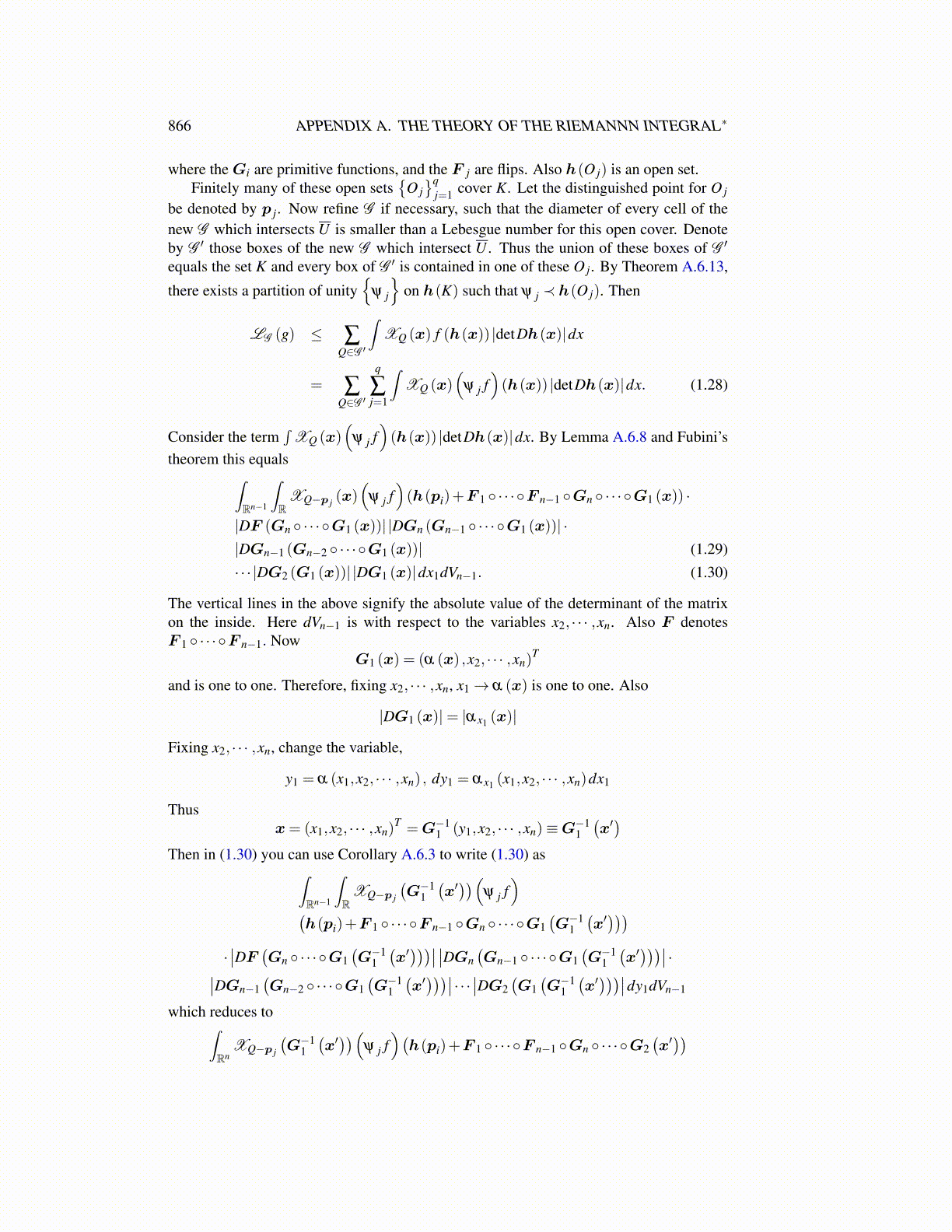
866 APPENDIX A. THE THEORY OF THE RIEMANNN INTEGRAL∗
where the Gi are primitive functions, and the F j are flips. Also h(O j) is an open set.Finitely many of these open sets
{O j}q
j=1 cover K. Let the distinguished point for O j
be denoted by p j. Now refine G if necessary, such that the diameter of every cell of thenew G which intersects U is smaller than a Lebesgue number for this open cover. Denoteby G ′ those boxes of the new G which intersect U . Thus the union of these boxes of G ′
equals the set K and every box of G ′ is contained in one of these O j. By Theorem A.6.13,
there exists a partition of unity{
ψ j
}on h(K) such that ψ j ≺ h(O j). Then
LG (g) ≤ ∑Q∈G ′
∫XQ (x) f (h(x)) |detDh(x)|dx
= ∑Q∈G ′
q
∑j=1
∫XQ (x)
(ψ j f
)(h(x)) |detDh(x)|dx. (1.28)
Consider the term∫
XQ (x)(
ψ j f)(h(x)) |detDh(x)|dx. By Lemma A.6.8 and Fubini’s
theorem this equals∫Rn−1
∫R
XQ−p j (x)(
ψ j f)(h(pi)+F 1 ◦ · · · ◦F n−1 ◦Gn ◦ · · · ◦G1 (x)) ·
|DF (Gn ◦ · · · ◦G1 (x))| |DGn (Gn−1 ◦ · · · ◦G1 (x))| ·|DGn−1 (Gn−2 ◦ · · · ◦G1 (x))| (1.29)· · · |DG2 (G1 (x))| |DG1 (x)|dx1dVn−1. (1.30)
The vertical lines in the above signify the absolute value of the determinant of the matrixon the inside. Here dVn−1 is with respect to the variables x2, · · · ,xn. Also F denotesF 1 ◦ · · · ◦F n−1. Now
G1 (x) = (α (x) ,x2, · · · ,xn)T
and is one to one. Therefore, fixing x2, · · · ,xn, x1→ α (x) is one to one. Also
|DG1 (x)|= |αx1 (x)|
Fixing x2, · · · ,xn, change the variable,
y1 = α (x1,x2, · · · ,xn) , dy1 = αx1 (x1,x2, · · · ,xn)dx1
Thusx= (x1,x2, · · · ,xn)
T =G−11 (y1,x2, · · · ,xn)≡G−1
1(x′)
Then in (1.30) you can use Corollary A.6.3 to write (1.30) as∫Rn−1
∫R
XQ−p j
(G−1
1(x′))(
ψ j f)
(h(pi)+F 1 ◦ · · · ◦F n−1 ◦Gn ◦ · · · ◦G1
(G−1
1(x′)))
·∣∣DF
(Gn ◦ · · · ◦G1
(G−1
1(x′)))∣∣ ∣∣DGn
(Gn−1 ◦ · · · ◦G1
(G−1
1(x′)))∣∣ ·∣∣DGn−1
(Gn−2 ◦ · · · ◦G1
(G−1
1(x′)))∣∣ · · · ∣∣DG2
(G1(G−1
1(x′)))∣∣dy1dVn−1
which reduces to∫Rn
XQ−p j
(G−1
1(x′))(
ψ j f)(
h(pi)+F 1 ◦ · · · ◦F n−1 ◦Gn ◦ · · · ◦G2(x′))